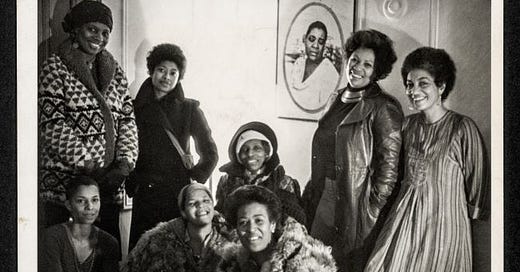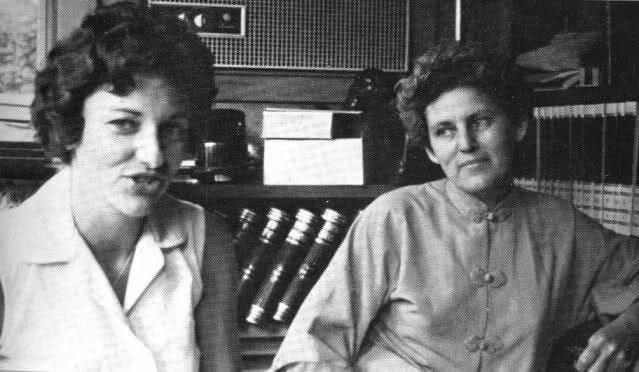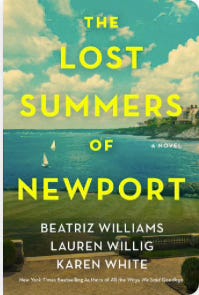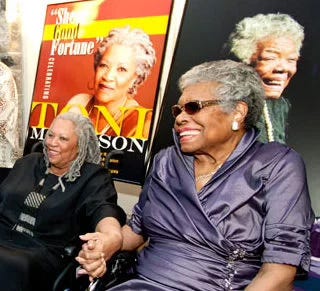Hey fearless listeners. We've made it to another week. That accomplishment isn’t something I take lightly. Times feel perilous. Worries are rampant. I’ve had more conversations where I’ve been talked off the ledge—or where I’ve held up safety nets for others.
But let’s congratulate ourselves. We’ve made it through the fire. California has literally done that, with most of the wildfires now 100% contained. Let me repeat this: We will get through hard times. My faith is strong, my friendships are firm. I believe in doing life with us, helping each other along the way.
As your historically inclined friend, I thought deeply about writers and writing friendships this week. As a writer, I love studying other writers. I look for habits to incorporate or styles to dissect and admire. There is so much that can be learned from reading and studying the craft of other. While there’s nothing new under the sun, some writers have found ways to capture its light and change the world by focusing its heat and power back on to the earth—our neighborhoods, communities, countries—even for just a mere moment.
I draw a lot on images. In my own writing, I want you to feel like you’re in the room where it happens. In Sister Mother Warrior, I make you the warrior Gran Toya, sitting at the table where the boy she raised, Jean Jacques Dessalines converses with the commander of the armed forces, Toussaint L’Overture. They speak about strategies to prosecute the war, and I spend time on the tastes of the foods on the table from broth and its caramelized bits to the roasted pheasant with mushrooms. If this scene were painted or dared to be shown on screen, you should catch the meticulous details and comforts of where they’re sitting, the posturing, even the fumbling of fingers along the buttons of a waistcoat that has crowns or birds or women painted upon them.
Images tell us so much. They are testament to what has been and what could be. Remembering photos of writer friendships like Ralph Ellison (Invisible Man) & Albert Murray (The Omni-Americans) and noting the dapper and different styles of dress. Or photos of James Baldwin & Langston Hughes taking in jazz or supporting a civil rights march—all our precious moments. So for this week’s essay, I went down a rabbit hole searching for images of female writer friendships.
Ralph Ellison, Langston Huges, and James Baldwin
Source: Instagram: @neicyreedus
I started with the Brontë Sisters—Charlotte (1816–1855), Emily (1818–1848), and Anne (1820–1849). These literary powerhouses from Yorkshire, England, originally published under male pseudonyms, but their female forward works—Charlotte’s Jane Eyre, Emily’s Wuthering Heights, and Anne’s The Tenant of Wildfell Hall became classics of English literature. I found myself looking at a painting of the sisters created in 1843 by their brother, Branwell Brontë. He originally painted himself into the portrait but seeing the sunshine, their luminous faces, he painted out his own image, leaving behind a ghostly outline.
Brontë Sisters—Charlotte (1816–1855), Emily (1818–1848), and Anne (1820–1849). Source: Wiki Commons.
Can you imagine Branwell’s humility and protective nature of his sisters and their genius. The portrait now hangs in the National Portrait Gallery in London for all to see.
From there, I dove into Sylvia Plath (1932–1963) and Anne Sexton (1928–1974). The two revolutionized confessional poetry, tackling themes of mental illness, feminism, and personal suffering. They often attended poetry workshops and lectures together, but I couldn’t find any pictures of them side by side. They may exist, but what if they don’t. What does that mean to have a friendship so secretive and private? To not celebrate the unity publicly—what does that say about feminine unity?
In contrast, I did find images of Anne Sexton and poet Maxine Kumin.
Anne Sexton and Maxine Kumin. SOURCE: karenmoline.com
After meeting Sylvia Plath for drinks, Anne still craved company, so she joined a local writers' group. This where she first heard Maxine Kumin—a quiet but powerful voice sharing a work in progress. They couldn’t have been more different: Maxine, prim and frumpy; Anne, wild and bold. But together, they were yin and yang. They edited each other’s work, co-wrote poems, and built a bond so deep that it became a true creative partnership. You know how rare it is to fully trust another writer with your words? That’s the kind of magic the two had.
One of my favorite modern writer friendships is the trio of Beatriz Williams, Lauren Willig, and Karen White. Their collaboration has produced, several books including The Lost Summers of Newport—one of my favorites. They’re often seen together at book events wearing pearls, sipping signature cocktails, and laughing with the kind of joy that only comes from shared secrets, success and sisterly love.
The Lost Summers of Newport: Beatriz Williams, Lauren Willig, Karen White
Another legendary literary sisterhood? Toni Morrison (1931–2019) & Maya Angelou (1928–2014). These two are iconic, two of the most important voices of the 20th century. I’ve seen photos of them young and free, standing tall in their brilliance. I’ve seen pictures of them in their later years, side by side in wheelchairs, dressed to the nines, radiating wisdom and grace. Their friendship was built on admiration, public support, and deep mutual respect.
Toni Morrison and Maya Angelou. Source: Virginia Tech News.
These images are so encouraging to me. As writers, we often work in solitude, wrestling with words and deadlines. But community matters. These friendships remind me of that.
There’s one more image I found in 2023. —It appeared in the LA Times article, touting a new book, The Sisterhood. The photo, which serves as the book’s cover, captures eight young, beautiful Black women gathered together, smiling for the camera. Let me set the scene...
The hostess, let’s call her June, was waiting for her collection of poems to be published in two months. Every author knows that feeling, the anxiety of waiting for pub day, the stomach-churning dread of the book’s reception, the early reviews. I can imagine June wanting her girls around her for support. She calls her writer friend Alice. Alice is a girl’s girl. She’s written a big exposé for Ms. Magazine and is so close to locating a literary treasure she can taste it. Tasting reminds of her spices. She picks up the rotary dial phone and calls the best cook she knows, Vertamae. Vertamae is a Brooklyn celebrity and a cultural anthropologist, but she brings a pot of gumbo with large shrimp, smoked sausage and proper Geechee rice.
More calls are made, and these writers and activists come to June’s apartment. One friend, I think Toni, who had a couple of books published and a little money in her pockets of her fine leather jacket brings the best champagne she can afford. Maybe one bottle of expensive Veuve Clicquot Brut with the Yellow Label to toast something real special. And then she purchases a few bottles of Moët & Chandon or maybe something sparkling and American like André or California Korbel.
Are you getting the picture? Glasses in hand, toasting each other. A 12-inch long-play album sings in the background Stevie Wonder’s “I Wish” or Rose Royce’s “Car Wash.” If June’s love for Bessie Smith wins out, she will make sure the Empress of the Blues’s “Downhearted Blues plays.” After the dishes were cleared, I can imagine them reciting poems, like Anne and Maxine. They might work on plot points or tweak a line or two, passing it amongst themselves, much like Beatriz, Lauren, and Karen.
And just as they ready to leave and tug on their jackets back to brave the February cold, someone suggests a picture. The ladies group together in the living room under June’s hanging picture of singer Bessie Smith. Click. Someone catches the moment. Much like Branwell Brontë, someone has gotten out of the way to commemorate this moment where the sun shined through and touched legends.
Let me formally introduce you to these women:
· June Jordan – A trailblazing poet, essayist, and activist whose work championed social justice, Black empowerment, and the experiences of marginalized communities. In the picture, she was two months away from publishing Things That I Do in the Dark (1977), a poetry collection reflecting on race, gender, and personal identity.
· Alice Walker – A Pulitzer Prize-winning author and activist, best known for her novel The Color Purple and her tireless efforts in preserving Zora Neale Hurston's legacy, Alice was an established writer, having published Meridian (1976), a novel exploring the civil rights movement.
· Vertamae Smart-Grosvenor – A culinary anthropologist, writer, and Gullah culture advocate is known for her work blending storytelling with food traditions, including her groundbreaking book Vibration Cooking: Or, the Travel Notes of a Geechee Girl (1970).
· Toni Morrison – A Nobel Prize-winning author and Random House editor celebrated for her powerful novels like Beloved that illuminate the complexities of Black life, memory, and history stands, all cool, in her leather coat. At the time of this gathering, Toni had already gained literary acclaim with The Bluest Eye (1970) and Sula (1973). By February 1977, she was months away from publishing Song of Solomon, which would earn her the National Book Critics Circle Award.
· Nana Maynard – A newbie who would go on to become a scholar and cultural advocate for highlighting the contributions of Black artists and writers is there in the front row.
· Ntozake Shange (Toe-zaka chan-gay) – A poet, playwright, and novelist renowned for her choreopoem For Colored Girls Who Have Considered Suicide / When the Rainbow Is Enuf, which helped redefined the portrayal of Black womanhood in art. She was a household name in the 70s and advanced Black feminist theater.
· Audreen Ballard – A gifted writer and thinker who worked for activism and celebrated Black culture, she became an active voice in literary feminist communities.
· Lori Sharpe – Lori was at the beginning of her career, but she went on to become an accomplished poet and writer whose works explore themes of identity, community, and Black womanhood.
Front Row (L to R): Audreen Ballard, Ntozake Shange, Nana Maynard
Back Row (L to R): Vertamae Smith- Grovenor, Alice Walker, Lori Sharpe, Toni Morrison, and June Jordan - Source LA Times.
This photo means the world to me--legends standing on business, celebrating and communing together. It shouts several things at once:
1. Because writing can be an isolated place, seek out friends.
2. Enjoy the best—whatever that may be—when you gather. Eat gumbo, drink the wine.
3. Differences in levels of talent, stages and stature in careers shouldn’t keep anyone from getting a bowl.
4. Toast every one and every accomplishment with good champagne
5. Record the moment. We need good memories.
When I go places, I’m often that one friend taking a hundred pictures. I try to be quick, and I’ve learned to snap photos in live mode. It’s the best way adjust things to make sure everyone looks their best—eyes open, expressions just right, etc. And sometimes static shots can be turned into video so I can relive the moment. It helps to feel not so isolated.
Lastly, it never hurts to be Branwell or the unknown one who snaps the picture. Don’t worry about hogging the light. Today more than ever, someone will catch you and your moment.
So, dear listeners, writers in the house, do something for me: Get with your friends—those soldiering in the same fields and include a few who are doing something different. Celebrate life. Stay hopeful about the things you’re expecting. You deserve delicious gumbo, champagne, and your best girls pouring life into you, just as you do the same for them.
More about information about sisterhoods and writing friendships can be found in the show notes, along with the reading list.
This week buy select books at Mahogany Books at Bookshop.Org.
Show Notes:
Literary Friendships:
Ellison, Ralph. Invisible Man. Random House, 1952.
Murray, Albert. The Omni-Americans: Some Alternatives to the Folklore of White Supremacy. Outerbridge & Dienstfrey, 1970.
Thorsson, Courtney. The Sisterhood: How a Network of Black Women Writers Changed American Culture. Columbia University Press, 2019.
Hamann, Jamie Lee. "Friendships: Maxine Kumin and Anne Sexton." HubPages, updated December 2, 2017.
Smart-Grosvenor, Vertamae. Vibration Cooking: Or, the Travel Notes of a Geechee Girl. Doubleday, 1970.
Morrison, Toni. The Bluest Eye. Holt, Rinehart and Winston, 1970.
Morrison, Toni. Song of Solomon. Alfred A. Knopf, 1977.
Walker, Alice. The Color Purple. Harcourt Brace Jovanovich, 1982.
Jordan, June. Things That I Do in the Dark. Doubleday, 1977.
Walker, Alice. Meridian. Harcourt Brace Jovanovich, 1976.
Williams, Beatriz, Lauren Willig, and Karen White. The Lost Summers of Newport. William Morrow, 2022.
Riley, Vanessa. Sister Mother Warrior, William Morrow 2022.
Thank you for listening. Hopefully you’ll come again. This is Vanessa Riley.






















Share this post